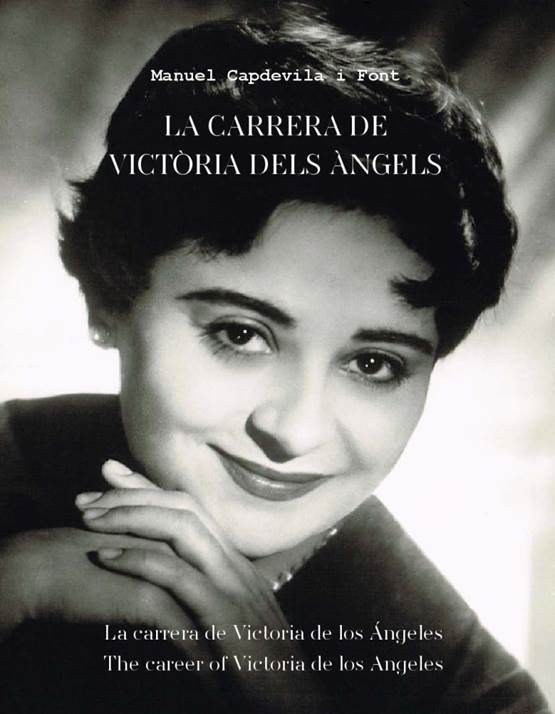
LA CARRERA DE VICTÒRIA DELS ÀNGELS (La carrera de Victoria de los Ángeles / The career of Victoria de los Ángeles) by Manuel Capdevila i Font
(all photos from the Charles Mintzer collection)

Témenos Edicions, Gran Teatre del Liceu & Fundació Victoria de los Ángeles - Barcelona 2013 (texts in Catalan, Spanish and English) hardbound, 673 p. (isbn: 978-84-941069-7-2)
Several books about Victoria de los Angeles have been published since the first small booklet by Bernard Gavoty (“Victoria de los Angeles”, Éditions René Kister, Genéve, 1956), all of them regarding her personal and artistic life. This new book, big and heavy, is a Chronology of her activities, including not only the usual operatic and concert performances, but also giving the dates for recording sessions, master classes, TV and radio concerts and interviews, benefits, concerts in private houses, even her singing at funerals. From December 1939 up to September 2000 it reaches the staggering number of 2452 events. Though I cannot claim to have read every singer biography published, I do not remember any other being as complete as this, which has taken Mr. Capdevila several years to compile. It may be that some obscure concert may have been omitted, but it will not make any difference.

The book has a 10-page Introduction and then follows a day by day chronology which takes 342 pages, roughly half the total of the book. Then the author has added seven very detailed appendices: 1) A yearly chronology giving date and city; 2) a separate listing of her 432 operatic performances, with date, city and work title; 3) a listing of all countries and cities where de los Angeles performed; 4) a similar listing but adding the number from the chronology (1-2452) of the activities in each city; 5) A detailed listing of all artists conductors, pianists, other musicians, and singers) which took part in her opera and concert performances; 6) a list of composers and their works (separately for opera, concert works, arias, and songs); 7) The number of her performances of each work listed in the previous appendix. Now really, appendices 3 and 4 could have been done together as well as annexes 6 and 7, without so many repetitions.
Each one of her 2452 entries in the Chronology includes date, place (country and city), location (theatre, television, radio or recording studio, house, concert hall, church, and any other location). This is followed by the opera title, her role and members of the cast, or the accompanist and list of works for concerts and solo recitals. Except the singer/role problem which I will mention later, the information is absolutely exhaustive.
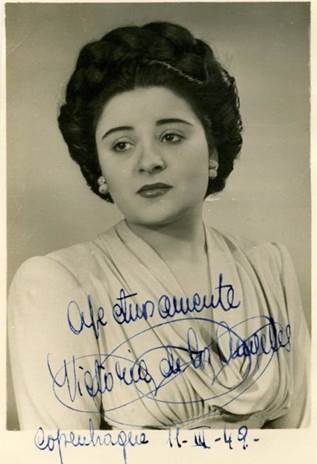
So far, so good. Alas, it seems that proof reading of the book has been nonexistent and the mistakes and/or typos count by hundreds, Of course the author is the first responsible of this problem, but in the Introduction he tells us that the text was checked exhaustively, adding “I luckily thought of sending another copy to Xavier Vivanco, who had been Victoria’s secretary for so many years, asking him to glance through it and correct any mistakes he might find. Much more than a glance, Xavier studied the whole document with great care…” So, even if Vivanco corrected and added more information, he must be considered co-responsible of such incredible and unusual number of errors.
I will list some of the mistakes in the Chronology, with the correct text in parenthesis, so the reader may have idea of the problem:
effrayable (effroyable), Perolessi (Pergolesi), ho io ne core (ho io nel core), I am lead in earth (laid), contesa (contessa), trübern (trüben), Guiseppe (Giuseppe), Manachini (Manacchini), rian (ríen), Pizzeti (Pizzetti), Allelua (Alleluia), Pucinini (Puccini), Zueinung (Zueignung); Fanco (Franco), Steffano (Stefano), Ungelduld (Ungeduld), Allerseen (Allerseelen), Lenchner (Lechner), Serfin (Serafin), L’extase (Extase), Diulio (Duilio), Mattheis (Matthaeis), Pugnanelli (Pignanelli); Fabritis (Fabritiis), Gionni (Gianni), Savaresse (Savarese), Violetta Coehlo (Violeta Coelho), Alvino (Alvinio), celloists (cellists), Marck (Mack), Radiio (Radio), Radciffe (Radcliffe), Alvaray (Alvary), Vorhees (Voorhees), Clliford (Clifford), abhabden (abhanden), Engelberg (Engelbert), Lusch (Lush), Latunicci (Latinucci), Stassio (Stasio), Stavinsky (Stravinsky), Vergelibche (Vergelibches), Nebie (Nebbie), Rotheberger (Rothenberger), jubal (Jubal), brasilerias (brasileiras), Valetti (Valletti), Raslose (Rastlose), de Palma (Di Palma), Upman (Uppman), suave (soave), aucells (ocells), Shérhérazade (Shéherázade), riendo (riyendo), Heide (Heidi), Glyndenbourne (Glyndebourne), Boatwrigt (Boatwright), Rainey (Reiner), filgio (figlio), Bilitils (Bilitis), populairs (populaires), claire (clair), acaient (avaient), recordidng (recording). Sharril (Sherrill), Nussbum (Nussbaum), Smnfonia (Sinfonía), Sottish (Scottish), Quan (Quand), trornasse (tornasse), Lulli (Lully), un oiseaux (oiseau), Jeanette (Jeannette), Mines (Milnes), Stänchen (Ständchen), pratti (prati), So shall de lute (so shall the lute), soralla (sorella), pupilette (pupillete), Lllibre (Llibre), Vergebeliches (Vergebliches), Pastorito (Pastorcito), Jjlgerillo (jilguerillo), vuoil (vuol), Paladhile (Paladilhe), Seguidillas de oficial (Seguidillas del oficial), Senhnsucht (Sehnsucht), Pastoralle (Pastorale), majo me mi vida (majo de mi vida), Sappische (Sapphische), pelegerinitos (pelegrinitos), Scotish (Scottish), Kirchhoffe (Kirchhofe), Salla (Sala)…
Some of these words appear badly written several times along the book. As for accents sometimes they are properly given, others are omitted and others are wrongly applied.
Other mistakes about well known facts could have been easily avoided. Regarding the Carmen recording (Nrs. 835 & 914), the original singer of Frasquita (Marcelle Croisier) died during the pause between sessions (Beecham came to Buenos Aires to conduct an opera season for several months in 1958, after beginning the recording in Paris the same year), and was replaced in the last sessions by Monique Linval. However Capdevila mentions them taking part in both sessions, though this fact is told in EMI’s booklet for the issue. And it is not easy to explain why Leo Blech, the well known German conductor (who died in 1967) appears conducting the London Chamber Players, instead of Harry Blech (1969), as surely the conductor’s name is correctly written in the printed program.

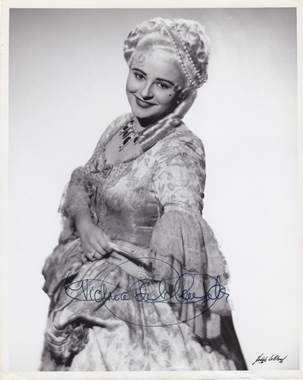 (in Butterfly and Manon, courtesy Charles Mintzer)
(in Butterfly and Manon, courtesy Charles Mintzer)
Regarding the casts for the complete opera performances, the author says: “I decided not to include the role played by each singer, so as not to make the book too bulky…”. Maybe Capdevila thought and was afraid that it would add many pages to his work, but really it would not be so. First, there are 39 performances (Combattimento, L’Orfeo, La serva padrona, Il segreto di Susanna) for which not a single new line would have been necessary, and then, I made a proof using the book size type for the other 390 performances, and counting all the new lines required, I arrived at a total of 10 pages. In a 670-page book as this, it means nothing, but would have been much better to have the missing information. A lost opportunity, when it was easily available to the author, either from the singer’s archives, printed programs, web pages, and theater chronologies.
The detailed information provided in the Chronology annexes (180 pages) is impressive, giving details of total number of performances in each country, each city, for every opera and any vocal work, not just a concert work like Brahms’ Requiem, but for each single aria and song or Lied she ever sang.
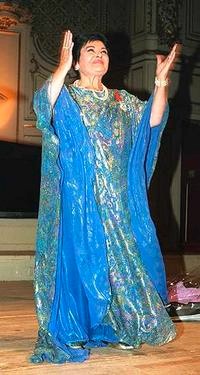
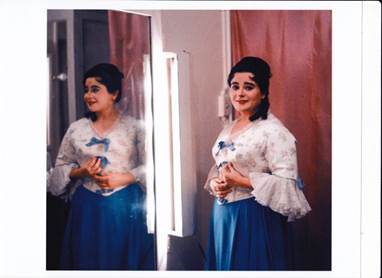
Now the problem arising from such detailed information is again the increased number of errors and mistakes, as in the first part of the book. Regarding dates there is a Faust (161) of 1953 appearing in 1933; Mitridate Eupatore (235) sung in 1956 listed as 1945; a performance of La Vida breve (419) sung in the year 2973, and other of the same opera (423) listed in 1998 instead of 1979. The mistakes crept again in the artists names: Cimarra (Cimara), Isay (Issay), Fabritis (Fabritiis), Flagellio (Flagello), Howad (Howard), Pritchad (Pritchard), Kar (Karl), Hugo (Ugo), Vorhees (Voorhees), Ashkenzy (Ashkenazy), Julien (Julian), Daniela (Daniele), Hamell Hamel), Latunicci (Latinucci), Macurdi (Macurdy), Marsch (Marsh), Alvino (Alvinio), Pugnanelli (Pignanelli), Raisberg (Raisbeck), Susanna (Susana), Hug (Huc), Eberhad, (Eberhard). Among other errors, the author lists Vichey and Vichegonov as different singers, when it is well known he is the same singer, Marcelle Croisier appears in Chronology No. 9014 instead of the correct number 914, and in the singers annex first names for some singers are omitted (Cazzato, Del Signore, Mercuriali, Rapisardi) when they are in the Chronology, this is clearly careless.
The others appendices have also new mistakes: Mitridrate (Mitridate), Ferarri (Ferrari), Goacchino (Gioacchino), Alessando (Alessandro), Franceso (Francesco), Napoleonne (Napoleone), Beacham (Beecham), Pahisa (Pahissa), Gacia ( Gracia), and certainly it would have been better to write “Broschi, Carlo (Farinelli)” instead of “Farinelli, Carlo Broschi”
After the Chronology Annexes, the author has added a Discography. This is divided in three sections, the first comprising the complete studio and live operatic issues, the second section all the other LP and CD releases, and a final very short third section with her twenty six double sided 78 rpm recordings issued between 1947 and 1953. The whole is preceded also by a one page Introduction, where the author mentions some very interesting recording projects which never took place. The list is mouth watering, including some operas Victoria sang in the theatre (Freischütz, Otello, Tannhäuser, a second Bohème), and others which she never sang (Eugene Onegin, Damnation de Faust, Orfeo ed Euridice) There is also a work that she sang only once: Beethoven’s Missa Solemnis (to be recorded under Toscanini). The author says that Xavier Vivanco gave him this information.
I do not have the complete knowledge of these facts, but certainly the reason given for the failure to record the Missa Solemnis, is not true. Capdevila states that the recording was scheduled by RCA after the live performances that Toscanini was to conduct at the Carnegie Hall, and because the date was at “…Christmas time and that meant that Victoria, who had not seen her parents for a year would be stopping in Barcelona until the following year” (sic, in the English translation of the book). We know that Toscanini did not conduct concerts during the Christmas and New Year celebrations for the 1946/47, 1947/48, 1948/49, 1949/50, 1951/52, 1952/53 and 1953/54 seasons (See Frank Mortimer’s “Arturo Toscanini-The NBC Years”, Amadeus Press, 2002). The Beethoven Missa Solemnis performance took place on March 28, 1953 and the RCA recording sessions on March 30, 31 and April 1, hardly Christmas time.
The projected Orfeo ed Euridice is also a very dubious assertion. De los Angeles never sang the title role (or even Euridice) either in concert or on the stage, though she included two arias in six concerts, these were sung four years after Klemperer’s last concert and two after his death. But there are further documents that tell a different story: Peter Heyworth in his masterful Klemperer biography (Cambridge University Press, 1996), tells us that negotiations with Klemperer to record this opera for EMI with Grace Bumbry took place in 1969, but the conductor wanted Janet Baker for the title role, and a new proposal (Baker, Heather Harper and Margaret Price) was discussed the next year, but again it was shelved. There is no mention of de los Angeles, though Heyworth had access to Klemperer’s letters at EMI archives. Of course she could have sung Euridice, but Capdevila does not mention this role. Incidentally, Capdevila says she sang the title role in Monteverdi’s L’Orfeo (Chr. No. 9), which may have been true, considering it took place in 1941 and was an End of Academic concert at the Liceu Conservatori for the pupils. But during her career she only sang the Messagiera scene “In un fiorito prato” no less than 177 times (from 1943 to 1997)
Though the author says that he includes all recordings issued up to the book publication (2012/2013), notable omissions include the EMI “ICON” compilation on 7 CDs (21730825) the biggest reissue from EMI up to now, and the “live” concert (April 9, 1955) when de los Angeles sang Les nuits d’été and La demoiselle élue (WHARA 6027) both of them issued many years ago.
All three Discopraphy sections have important omissions and mistakes. In the opera recordings list, both Pelléas et Mélisande (1962) and Werther (1979) from the Teatro Colon issued on the Ornamenti and New Ornamenti labels are omitted, while there is no mention that the 1951 Copenhague Bohème is only a selection from the opera.
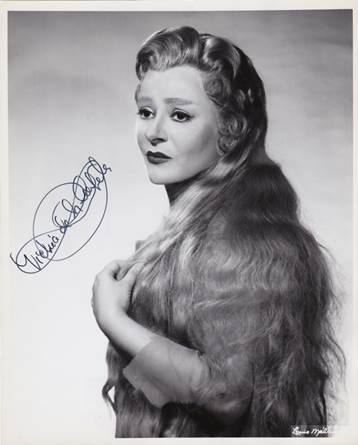
(as Mélisande, courtesy Charles Mintzer)
The second section devoted to concert works has no alphabetical or chronological order, it must be considered just a mere guide to the artist recorded output. A pity since as she recorded almost exclusively for EMI it was surely easy to provide the usual complete information, though the dates and recording studios can be found in the Chronology. The assertion that the first recording of Falla’s two arias from La vida breve were recorded in Italian is one of the worse mistakes and I could not find any other written source for that.
The short –two pages- last section, is the list of her 78 rpm recordings for EMI. I could not have access to a complete catalogue for those releases, but certainly Farruca (Turina) and Clavelitos (Valverde) were issued on HMV DA 1926, not DA 1929 as Capdevila mentions.
Mistakes and typos in the Discography abound: Blanch (Blanc), Radclcliff (Radcliffe), Fübeck (Frübeck), pastocito (Pastorcito); Schalf (Schlaf), Sappische (Sapphische), Pagiacci (Pagliacci), involame (involami), La fille de Cadiz (Les filles de Cadix), bonna (buona), Yehudy (Yehudi), Vorhees, Vorrhees (Voorhees), ille (île), Valleti (Valletti), Direcor (Director), Fredeic (Frederic), Mandolline (Mandoline), Amèllia (Amèlia), Stäbchen (Ständchen), Jacikillar (Jacquillat), Sanatini (Santini), Cavellitos (Clavelitos), Marea (Mare), ryiendo (riyendo), Suskind (Susskind), Phlharmonia (Philharmonia), Geradl (Gerald), even, and it would be a good joke, but is infuriating: Isaac Newton playing the piano for Victoria de los Angeles on HMV DA 1930…
After the Discography the author give us 36 pages in which singers, pianists, actors, poets, conductors, writers, composers, clowns, give their opinion about de los Angeles. The last two pages are devoted to a Prologue written in 1982 by Josep Ma. Lamaña for a book that remains unpublished, certainly this very fine last and long essay would have been enough appreciation of de los Angeles gifts.
At the end of the book there is a 30-page section of photographs, many of them unknown, at least to me. The letter size is small but clearly printed with enough space between lines, so there it is not difficult to follow the text.
So, we have a really very important but also a flawed book. Probably we will never know why it was not properly read and corrected before printing. Still I would not be without it on my shelves, for Victoria de los Angeles was, and surely will remain, as Giacomo Lauri Volpi says in his “Voci paralelle” (Garzanti, 1956), a “unique voice” .
Cesar A. Dillon, Buenos Aires, October 2013
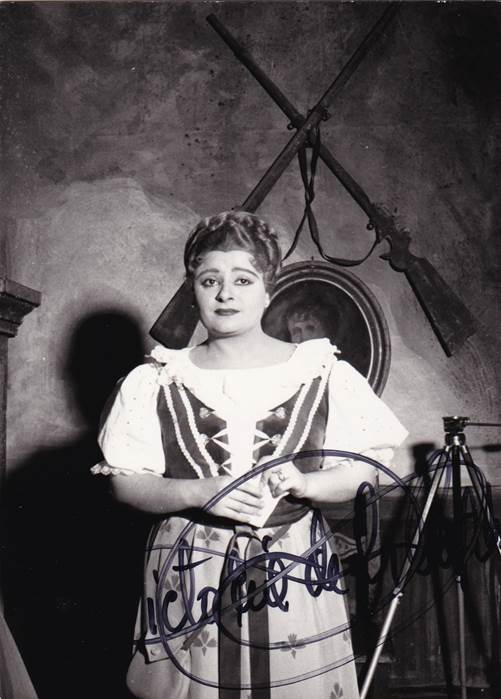 (as Agathe at la Scala, courtesy Charles Mintzer)
(as Agathe at la Scala, courtesy Charles Mintzer)